Defining Ordinary Race: Cultural, Behavioral, and Physical Differences
VerifiedAdded on 2023/01/05
|8
|2998
|77
Essay
AI Summary
This essay delves into the multifaceted concept of "ordinary race," exploring its definition through cultural, behavioral, and physical differences. It examines how these differences, stemming from geographical locations and historical contexts, contribute to the formation of racial identities. The essay critically analyzes the implications of race, particularly the societal notions and prejudices that associate moral character with skin color, leading to discrimination and potential economic and social problems. It underscores the importance of cultural awareness and social sciences to combat racism and foster a society that values individuals for who they are, not for their race. The essay concludes that the core concept of ordinary race relates to differences in body structures and somatic markers, emphasizing that racial prejudice has no place in modern society.
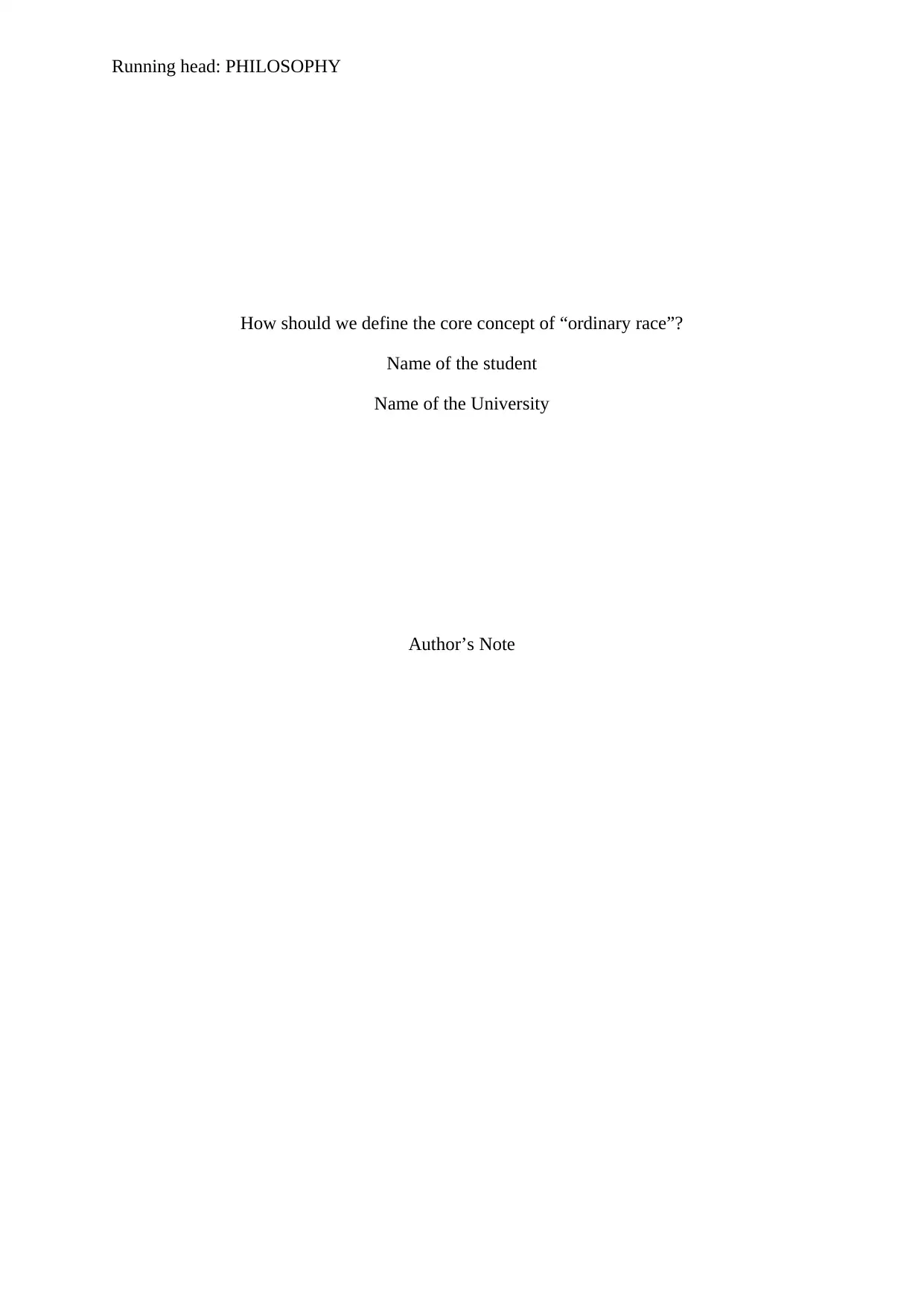
Running head: PHILOSOPHY
How should we define the core concept of “ordinary race”?
Name of the student
Name of the University
Author’s Note
How should we define the core concept of “ordinary race”?
Name of the student
Name of the University
Author’s Note
Paraphrase This Document
Need a fresh take? Get an instant paraphrase of this document with our AI Paraphraser
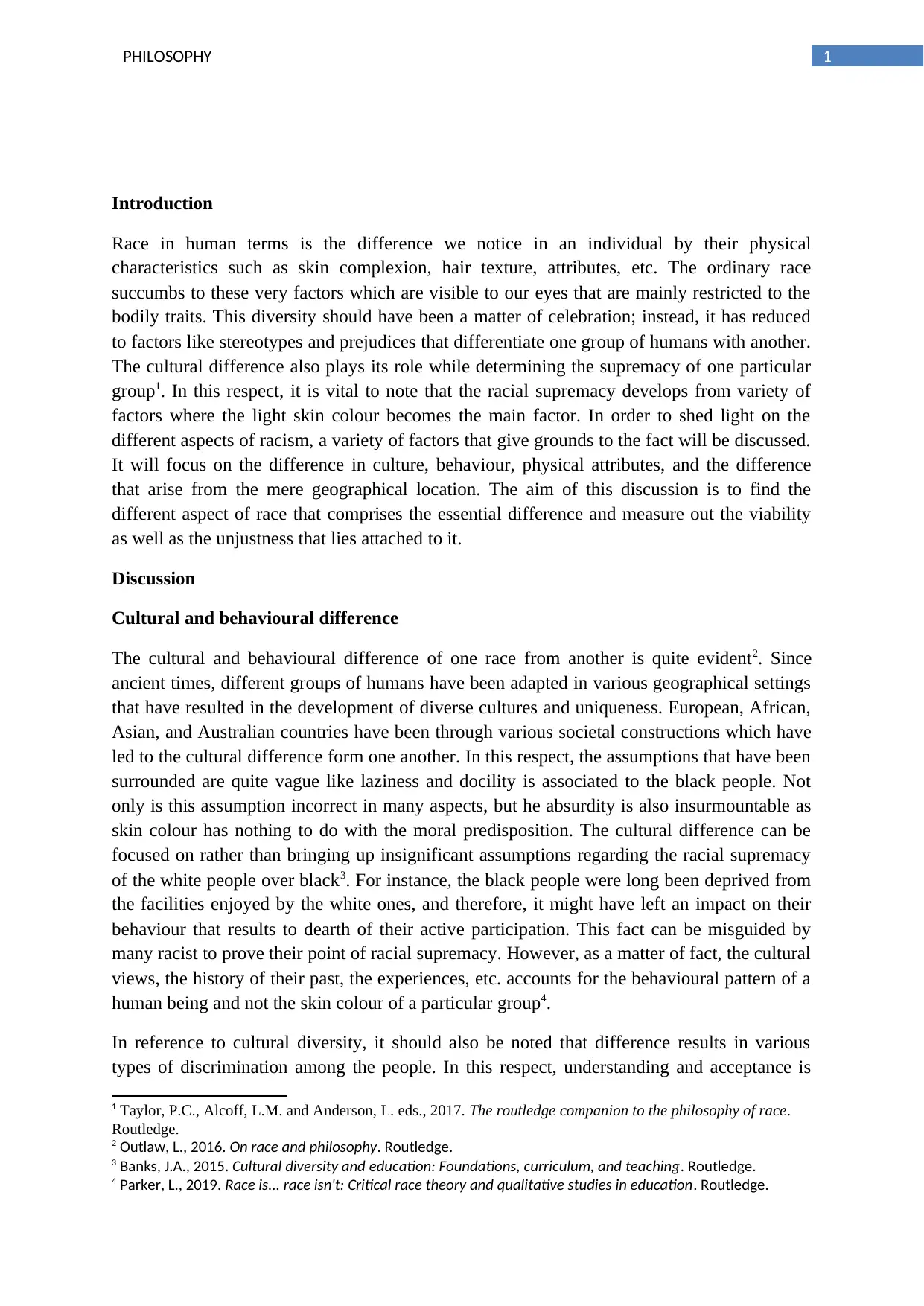
1PHILOSOPHY
Introduction
Race in human terms is the difference we notice in an individual by their physical
characteristics such as skin complexion, hair texture, attributes, etc. The ordinary race
succumbs to these very factors which are visible to our eyes that are mainly restricted to the
bodily traits. This diversity should have been a matter of celebration; instead, it has reduced
to factors like stereotypes and prejudices that differentiate one group of humans with another.
The cultural difference also plays its role while determining the supremacy of one particular
group1. In this respect, it is vital to note that the racial supremacy develops from variety of
factors where the light skin colour becomes the main factor. In order to shed light on the
different aspects of racism, a variety of factors that give grounds to the fact will be discussed.
It will focus on the difference in culture, behaviour, physical attributes, and the difference
that arise from the mere geographical location. The aim of this discussion is to find the
different aspect of race that comprises the essential difference and measure out the viability
as well as the unjustness that lies attached to it.
Discussion
Cultural and behavioural difference
The cultural and behavioural difference of one race from another is quite evident2. Since
ancient times, different groups of humans have been adapted in various geographical settings
that have resulted in the development of diverse cultures and uniqueness. European, African,
Asian, and Australian countries have been through various societal constructions which have
led to the cultural difference form one another. In this respect, the assumptions that have been
surrounded are quite vague like laziness and docility is associated to the black people. Not
only is this assumption incorrect in many aspects, but he absurdity is also insurmountable as
skin colour has nothing to do with the moral predisposition. The cultural difference can be
focused on rather than bringing up insignificant assumptions regarding the racial supremacy
of the white people over black3. For instance, the black people were long been deprived from
the facilities enjoyed by the white ones, and therefore, it might have left an impact on their
behaviour that results to dearth of their active participation. This fact can be misguided by
many racist to prove their point of racial supremacy. However, as a matter of fact, the cultural
views, the history of their past, the experiences, etc. accounts for the behavioural pattern of a
human being and not the skin colour of a particular group4.
In reference to cultural diversity, it should also be noted that difference results in various
types of discrimination among the people. In this respect, understanding and acceptance is
1 Taylor, P.C., Alcoff, L.M. and Anderson, L. eds., 2017. The routledge companion to the philosophy of race.
Routledge.
2 Outlaw, L., 2016. On race and philosophy. Routledge.
3 Banks, J.A., 2015. Cultural diversity and education: Foundations, curriculum, and teaching. Routledge.
4 Parker, L., 2019. Race is... race isn't: Critical race theory and qualitative studies in education. Routledge.
Introduction
Race in human terms is the difference we notice in an individual by their physical
characteristics such as skin complexion, hair texture, attributes, etc. The ordinary race
succumbs to these very factors which are visible to our eyes that are mainly restricted to the
bodily traits. This diversity should have been a matter of celebration; instead, it has reduced
to factors like stereotypes and prejudices that differentiate one group of humans with another.
The cultural difference also plays its role while determining the supremacy of one particular
group1. In this respect, it is vital to note that the racial supremacy develops from variety of
factors where the light skin colour becomes the main factor. In order to shed light on the
different aspects of racism, a variety of factors that give grounds to the fact will be discussed.
It will focus on the difference in culture, behaviour, physical attributes, and the difference
that arise from the mere geographical location. The aim of this discussion is to find the
different aspect of race that comprises the essential difference and measure out the viability
as well as the unjustness that lies attached to it.
Discussion
Cultural and behavioural difference
The cultural and behavioural difference of one race from another is quite evident2. Since
ancient times, different groups of humans have been adapted in various geographical settings
that have resulted in the development of diverse cultures and uniqueness. European, African,
Asian, and Australian countries have been through various societal constructions which have
led to the cultural difference form one another. In this respect, the assumptions that have been
surrounded are quite vague like laziness and docility is associated to the black people. Not
only is this assumption incorrect in many aspects, but he absurdity is also insurmountable as
skin colour has nothing to do with the moral predisposition. The cultural difference can be
focused on rather than bringing up insignificant assumptions regarding the racial supremacy
of the white people over black3. For instance, the black people were long been deprived from
the facilities enjoyed by the white ones, and therefore, it might have left an impact on their
behaviour that results to dearth of their active participation. This fact can be misguided by
many racist to prove their point of racial supremacy. However, as a matter of fact, the cultural
views, the history of their past, the experiences, etc. accounts for the behavioural pattern of a
human being and not the skin colour of a particular group4.
In reference to cultural diversity, it should also be noted that difference results in various
types of discrimination among the people. In this respect, understanding and acceptance is
1 Taylor, P.C., Alcoff, L.M. and Anderson, L. eds., 2017. The routledge companion to the philosophy of race.
Routledge.
2 Outlaw, L., 2016. On race and philosophy. Routledge.
3 Banks, J.A., 2015. Cultural diversity and education: Foundations, curriculum, and teaching. Routledge.
4 Parker, L., 2019. Race is... race isn't: Critical race theory and qualitative studies in education. Routledge.
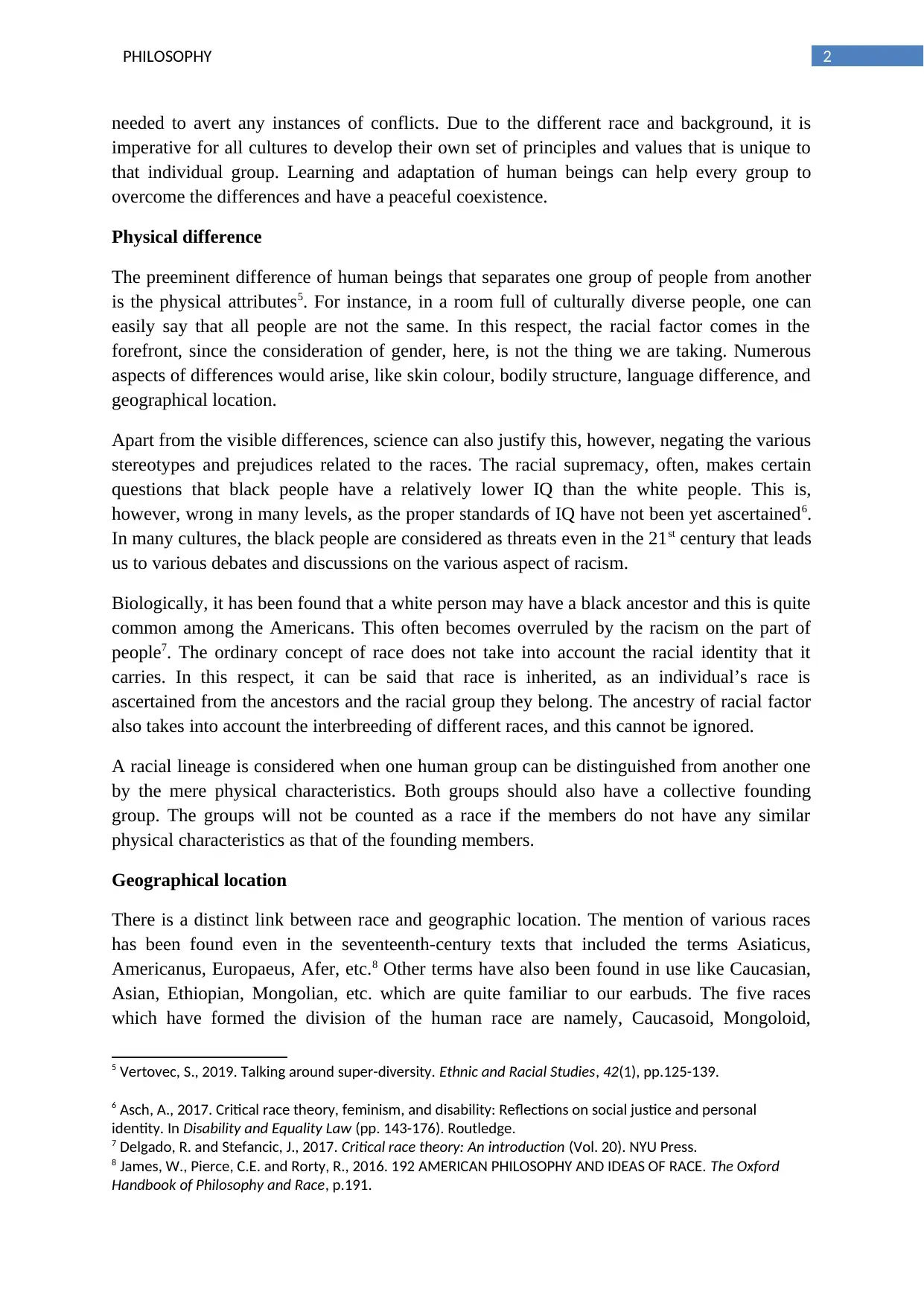
2PHILOSOPHY
needed to avert any instances of conflicts. Due to the different race and background, it is
imperative for all cultures to develop their own set of principles and values that is unique to
that individual group. Learning and adaptation of human beings can help every group to
overcome the differences and have a peaceful coexistence.
Physical difference
The preeminent difference of human beings that separates one group of people from another
is the physical attributes5. For instance, in a room full of culturally diverse people, one can
easily say that all people are not the same. In this respect, the racial factor comes in the
forefront, since the consideration of gender, here, is not the thing we are taking. Numerous
aspects of differences would arise, like skin colour, bodily structure, language difference, and
geographical location.
Apart from the visible differences, science can also justify this, however, negating the various
stereotypes and prejudices related to the races. The racial supremacy, often, makes certain
questions that black people have a relatively lower IQ than the white people. This is,
however, wrong in many levels, as the proper standards of IQ have not been yet ascertained6.
In many cultures, the black people are considered as threats even in the 21st century that leads
us to various debates and discussions on the various aspect of racism.
Biologically, it has been found that a white person may have a black ancestor and this is quite
common among the Americans. This often becomes overruled by the racism on the part of
people7. The ordinary concept of race does not take into account the racial identity that it
carries. In this respect, it can be said that race is inherited, as an individual’s race is
ascertained from the ancestors and the racial group they belong. The ancestry of racial factor
also takes into account the interbreeding of different races, and this cannot be ignored.
A racial lineage is considered when one human group can be distinguished from another one
by the mere physical characteristics. Both groups should also have a collective founding
group. The groups will not be counted as a race if the members do not have any similar
physical characteristics as that of the founding members.
Geographical location
There is a distinct link between race and geographic location. The mention of various races
has been found even in the seventeenth-century texts that included the terms Asiaticus,
Americanus, Europaeus, Afer, etc.8 Other terms have also been found in use like Caucasian,
Asian, Ethiopian, Mongolian, etc. which are quite familiar to our earbuds. The five races
which have formed the division of the human race are namely, Caucasoid, Mongoloid,
5 Vertovec, S., 2019. Talking around super-diversity. Ethnic and Racial Studies, 42(1), pp.125-139.
6 Asch, A., 2017. Critical race theory, feminism, and disability: Reflections on social justice and personal
identity. In Disability and Equality Law (pp. 143-176). Routledge.
7 Delgado, R. and Stefancic, J., 2017. Critical race theory: An introduction (Vol. 20). NYU Press.
8 James, W., Pierce, C.E. and Rorty, R., 2016. 192 AMERICAN PHILOSOPHY AND IDEAS OF RACE. The Oxford
Handbook of Philosophy and Race, p.191.
needed to avert any instances of conflicts. Due to the different race and background, it is
imperative for all cultures to develop their own set of principles and values that is unique to
that individual group. Learning and adaptation of human beings can help every group to
overcome the differences and have a peaceful coexistence.
Physical difference
The preeminent difference of human beings that separates one group of people from another
is the physical attributes5. For instance, in a room full of culturally diverse people, one can
easily say that all people are not the same. In this respect, the racial factor comes in the
forefront, since the consideration of gender, here, is not the thing we are taking. Numerous
aspects of differences would arise, like skin colour, bodily structure, language difference, and
geographical location.
Apart from the visible differences, science can also justify this, however, negating the various
stereotypes and prejudices related to the races. The racial supremacy, often, makes certain
questions that black people have a relatively lower IQ than the white people. This is,
however, wrong in many levels, as the proper standards of IQ have not been yet ascertained6.
In many cultures, the black people are considered as threats even in the 21st century that leads
us to various debates and discussions on the various aspect of racism.
Biologically, it has been found that a white person may have a black ancestor and this is quite
common among the Americans. This often becomes overruled by the racism on the part of
people7. The ordinary concept of race does not take into account the racial identity that it
carries. In this respect, it can be said that race is inherited, as an individual’s race is
ascertained from the ancestors and the racial group they belong. The ancestry of racial factor
also takes into account the interbreeding of different races, and this cannot be ignored.
A racial lineage is considered when one human group can be distinguished from another one
by the mere physical characteristics. Both groups should also have a collective founding
group. The groups will not be counted as a race if the members do not have any similar
physical characteristics as that of the founding members.
Geographical location
There is a distinct link between race and geographic location. The mention of various races
has been found even in the seventeenth-century texts that included the terms Asiaticus,
Americanus, Europaeus, Afer, etc.8 Other terms have also been found in use like Caucasian,
Asian, Ethiopian, Mongolian, etc. which are quite familiar to our earbuds. The five races
which have formed the division of the human race are namely, Caucasoid, Mongoloid,
5 Vertovec, S., 2019. Talking around super-diversity. Ethnic and Racial Studies, 42(1), pp.125-139.
6 Asch, A., 2017. Critical race theory, feminism, and disability: Reflections on social justice and personal
identity. In Disability and Equality Law (pp. 143-176). Routledge.
7 Delgado, R. and Stefancic, J., 2017. Critical race theory: An introduction (Vol. 20). NYU Press.
8 James, W., Pierce, C.E. and Rorty, R., 2016. 192 AMERICAN PHILOSOPHY AND IDEAS OF RACE. The Oxford
Handbook of Philosophy and Race, p.191.
⊘ This is a preview!⊘
Do you want full access?
Subscribe today to unlock all pages.

Trusted by 1+ million students worldwide
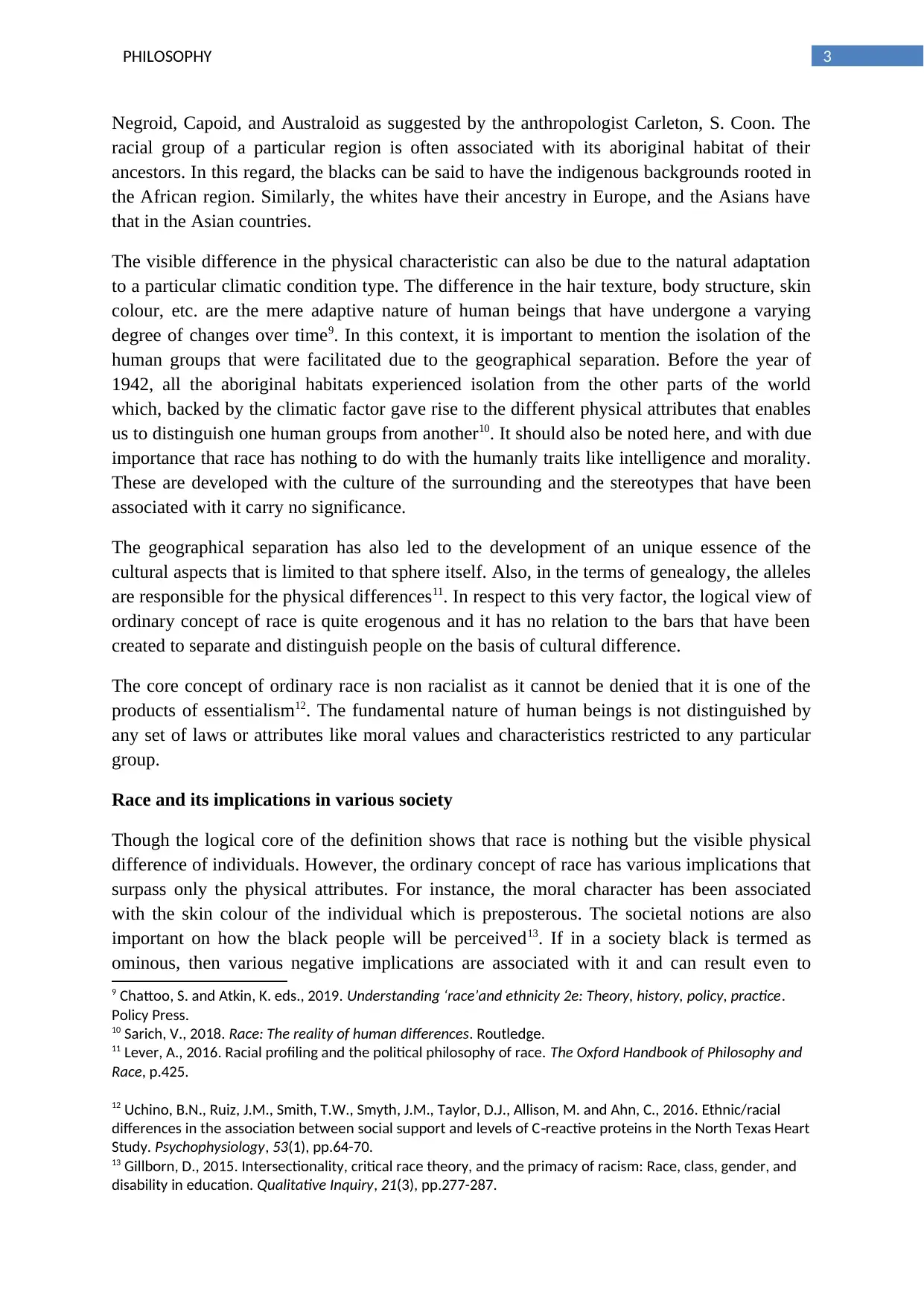
3PHILOSOPHY
Negroid, Capoid, and Australoid as suggested by the anthropologist Carleton, S. Coon. The
racial group of a particular region is often associated with its aboriginal habitat of their
ancestors. In this regard, the blacks can be said to have the indigenous backgrounds rooted in
the African region. Similarly, the whites have their ancestry in Europe, and the Asians have
that in the Asian countries.
The visible difference in the physical characteristic can also be due to the natural adaptation
to a particular climatic condition type. The difference in the hair texture, body structure, skin
colour, etc. are the mere adaptive nature of human beings that have undergone a varying
degree of changes over time9. In this context, it is important to mention the isolation of the
human groups that were facilitated due to the geographical separation. Before the year of
1942, all the aboriginal habitats experienced isolation from the other parts of the world
which, backed by the climatic factor gave rise to the different physical attributes that enables
us to distinguish one human groups from another10. It should also be noted here, and with due
importance that race has nothing to do with the humanly traits like intelligence and morality.
These are developed with the culture of the surrounding and the stereotypes that have been
associated with it carry no significance.
The geographical separation has also led to the development of an unique essence of the
cultural aspects that is limited to that sphere itself. Also, in the terms of genealogy, the alleles
are responsible for the physical differences11. In respect to this very factor, the logical view of
ordinary concept of race is quite erogenous and it has no relation to the bars that have been
created to separate and distinguish people on the basis of cultural difference.
The core concept of ordinary race is non racialist as it cannot be denied that it is one of the
products of essentialism12. The fundamental nature of human beings is not distinguished by
any set of laws or attributes like moral values and characteristics restricted to any particular
group.
Race and its implications in various society
Though the logical core of the definition shows that race is nothing but the visible physical
difference of individuals. However, the ordinary concept of race has various implications that
surpass only the physical attributes. For instance, the moral character has been associated
with the skin colour of the individual which is preposterous. The societal notions are also
important on how the black people will be perceived13. If in a society black is termed as
ominous, then various negative implications are associated with it and can result even to
9 Chattoo, S. and Atkin, K. eds., 2019. Understanding ‘race’and ethnicity 2e: Theory, history, policy, practice.
Policy Press.
10 Sarich, V., 2018. Race: The reality of human differences. Routledge.
11 Lever, A., 2016. Racial profiling and the political philosophy of race. The Oxford Handbook of Philosophy and
Race, p.425.
12 Uchino, B.N., Ruiz, J.M., Smith, T.W., Smyth, J.M., Taylor, D.J., Allison, M. and Ahn, C., 2016. Ethnic/racial
differences in the association between social support and levels of C reactive proteins in the North Texas Heart‐
Study. Psychophysiology, 53(1), pp.64-70.
13 Gillborn, D., 2015. Intersectionality, critical race theory, and the primacy of racism: Race, class, gender, and
disability in education. Qualitative Inquiry, 21(3), pp.277-287.
Negroid, Capoid, and Australoid as suggested by the anthropologist Carleton, S. Coon. The
racial group of a particular region is often associated with its aboriginal habitat of their
ancestors. In this regard, the blacks can be said to have the indigenous backgrounds rooted in
the African region. Similarly, the whites have their ancestry in Europe, and the Asians have
that in the Asian countries.
The visible difference in the physical characteristic can also be due to the natural adaptation
to a particular climatic condition type. The difference in the hair texture, body structure, skin
colour, etc. are the mere adaptive nature of human beings that have undergone a varying
degree of changes over time9. In this context, it is important to mention the isolation of the
human groups that were facilitated due to the geographical separation. Before the year of
1942, all the aboriginal habitats experienced isolation from the other parts of the world
which, backed by the climatic factor gave rise to the different physical attributes that enables
us to distinguish one human groups from another10. It should also be noted here, and with due
importance that race has nothing to do with the humanly traits like intelligence and morality.
These are developed with the culture of the surrounding and the stereotypes that have been
associated with it carry no significance.
The geographical separation has also led to the development of an unique essence of the
cultural aspects that is limited to that sphere itself. Also, in the terms of genealogy, the alleles
are responsible for the physical differences11. In respect to this very factor, the logical view of
ordinary concept of race is quite erogenous and it has no relation to the bars that have been
created to separate and distinguish people on the basis of cultural difference.
The core concept of ordinary race is non racialist as it cannot be denied that it is one of the
products of essentialism12. The fundamental nature of human beings is not distinguished by
any set of laws or attributes like moral values and characteristics restricted to any particular
group.
Race and its implications in various society
Though the logical core of the definition shows that race is nothing but the visible physical
difference of individuals. However, the ordinary concept of race has various implications that
surpass only the physical attributes. For instance, the moral character has been associated
with the skin colour of the individual which is preposterous. The societal notions are also
important on how the black people will be perceived13. If in a society black is termed as
ominous, then various negative implications are associated with it and can result even to
9 Chattoo, S. and Atkin, K. eds., 2019. Understanding ‘race’and ethnicity 2e: Theory, history, policy, practice.
Policy Press.
10 Sarich, V., 2018. Race: The reality of human differences. Routledge.
11 Lever, A., 2016. Racial profiling and the political philosophy of race. The Oxford Handbook of Philosophy and
Race, p.425.
12 Uchino, B.N., Ruiz, J.M., Smith, T.W., Smyth, J.M., Taylor, D.J., Allison, M. and Ahn, C., 2016. Ethnic/racial
differences in the association between social support and levels of C reactive proteins in the North Texas Heart‐
Study. Psychophysiology, 53(1), pp.64-70.
13 Gillborn, D., 2015. Intersectionality, critical race theory, and the primacy of racism: Race, class, gender, and
disability in education. Qualitative Inquiry, 21(3), pp.277-287.
Paraphrase This Document
Need a fresh take? Get an instant paraphrase of this document with our AI Paraphraser
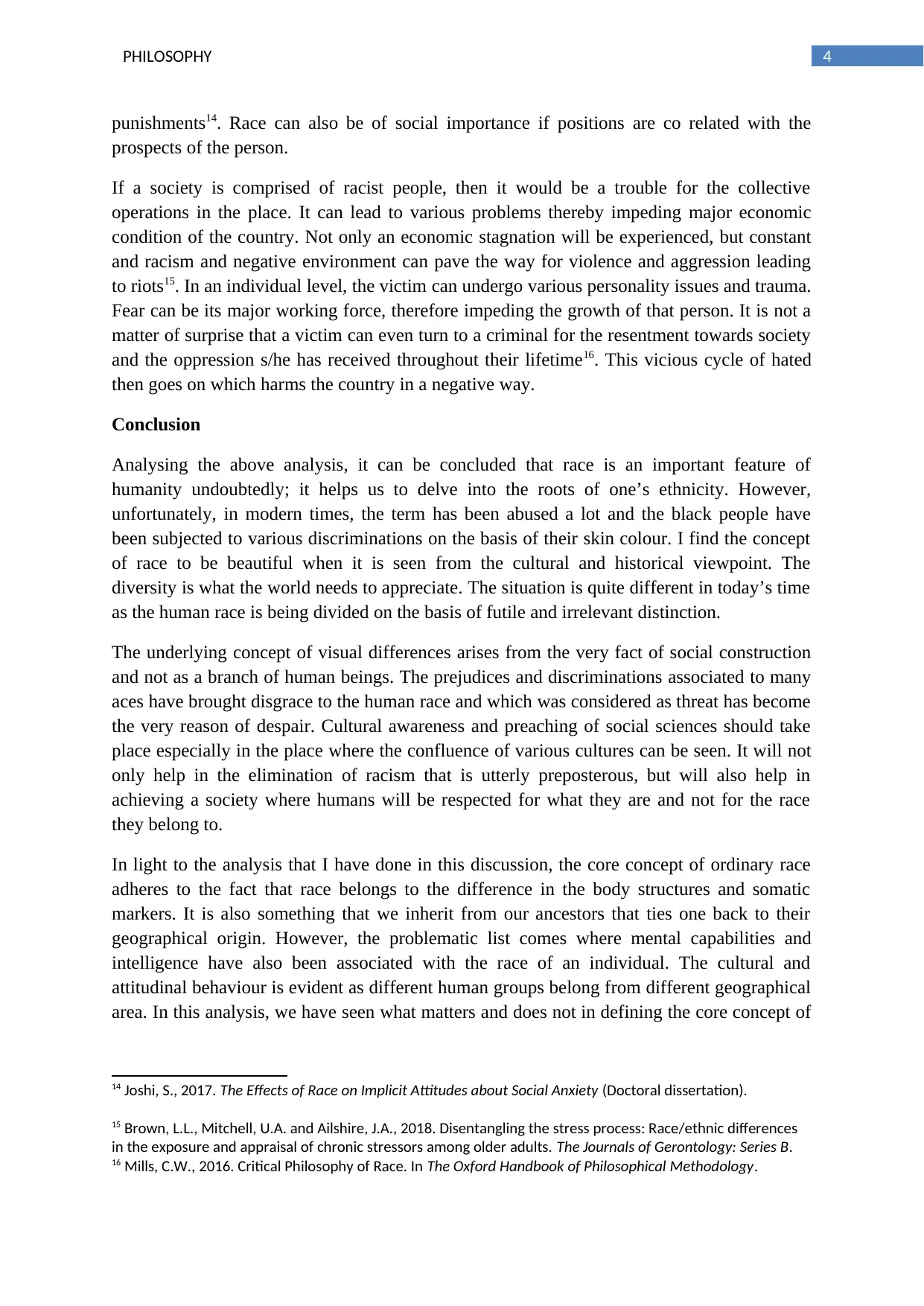
4PHILOSOPHY
punishments14. Race can also be of social importance if positions are co related with the
prospects of the person.
If a society is comprised of racist people, then it would be a trouble for the collective
operations in the place. It can lead to various problems thereby impeding major economic
condition of the country. Not only an economic stagnation will be experienced, but constant
and racism and negative environment can pave the way for violence and aggression leading
to riots15. In an individual level, the victim can undergo various personality issues and trauma.
Fear can be its major working force, therefore impeding the growth of that person. It is not a
matter of surprise that a victim can even turn to a criminal for the resentment towards society
and the oppression s/he has received throughout their lifetime16. This vicious cycle of hated
then goes on which harms the country in a negative way.
Conclusion
Analysing the above analysis, it can be concluded that race is an important feature of
humanity undoubtedly; it helps us to delve into the roots of one’s ethnicity. However,
unfortunately, in modern times, the term has been abused a lot and the black people have
been subjected to various discriminations on the basis of their skin colour. I find the concept
of race to be beautiful when it is seen from the cultural and historical viewpoint. The
diversity is what the world needs to appreciate. The situation is quite different in today’s time
as the human race is being divided on the basis of futile and irrelevant distinction.
The underlying concept of visual differences arises from the very fact of social construction
and not as a branch of human beings. The prejudices and discriminations associated to many
aces have brought disgrace to the human race and which was considered as threat has become
the very reason of despair. Cultural awareness and preaching of social sciences should take
place especially in the place where the confluence of various cultures can be seen. It will not
only help in the elimination of racism that is utterly preposterous, but will also help in
achieving a society where humans will be respected for what they are and not for the race
they belong to.
In light to the analysis that I have done in this discussion, the core concept of ordinary race
adheres to the fact that race belongs to the difference in the body structures and somatic
markers. It is also something that we inherit from our ancestors that ties one back to their
geographical origin. However, the problematic list comes where mental capabilities and
intelligence have also been associated with the race of an individual. The cultural and
attitudinal behaviour is evident as different human groups belong from different geographical
area. In this analysis, we have seen what matters and does not in defining the core concept of
14 Joshi, S., 2017. The Effects of Race on Implicit Attitudes about Social Anxiety (Doctoral dissertation).
15 Brown, L.L., Mitchell, U.A. and Ailshire, J.A., 2018. Disentangling the stress process: Race/ethnic differences
in the exposure and appraisal of chronic stressors among older adults. The Journals of Gerontology: Series B.
16 Mills, C.W., 2016. Critical Philosophy of Race. In The Oxford Handbook of Philosophical Methodology.
punishments14. Race can also be of social importance if positions are co related with the
prospects of the person.
If a society is comprised of racist people, then it would be a trouble for the collective
operations in the place. It can lead to various problems thereby impeding major economic
condition of the country. Not only an economic stagnation will be experienced, but constant
and racism and negative environment can pave the way for violence and aggression leading
to riots15. In an individual level, the victim can undergo various personality issues and trauma.
Fear can be its major working force, therefore impeding the growth of that person. It is not a
matter of surprise that a victim can even turn to a criminal for the resentment towards society
and the oppression s/he has received throughout their lifetime16. This vicious cycle of hated
then goes on which harms the country in a negative way.
Conclusion
Analysing the above analysis, it can be concluded that race is an important feature of
humanity undoubtedly; it helps us to delve into the roots of one’s ethnicity. However,
unfortunately, in modern times, the term has been abused a lot and the black people have
been subjected to various discriminations on the basis of their skin colour. I find the concept
of race to be beautiful when it is seen from the cultural and historical viewpoint. The
diversity is what the world needs to appreciate. The situation is quite different in today’s time
as the human race is being divided on the basis of futile and irrelevant distinction.
The underlying concept of visual differences arises from the very fact of social construction
and not as a branch of human beings. The prejudices and discriminations associated to many
aces have brought disgrace to the human race and which was considered as threat has become
the very reason of despair. Cultural awareness and preaching of social sciences should take
place especially in the place where the confluence of various cultures can be seen. It will not
only help in the elimination of racism that is utterly preposterous, but will also help in
achieving a society where humans will be respected for what they are and not for the race
they belong to.
In light to the analysis that I have done in this discussion, the core concept of ordinary race
adheres to the fact that race belongs to the difference in the body structures and somatic
markers. It is also something that we inherit from our ancestors that ties one back to their
geographical origin. However, the problematic list comes where mental capabilities and
intelligence have also been associated with the race of an individual. The cultural and
attitudinal behaviour is evident as different human groups belong from different geographical
area. In this analysis, we have seen what matters and does not in defining the core concept of
14 Joshi, S., 2017. The Effects of Race on Implicit Attitudes about Social Anxiety (Doctoral dissertation).
15 Brown, L.L., Mitchell, U.A. and Ailshire, J.A., 2018. Disentangling the stress process: Race/ethnic differences
in the exposure and appraisal of chronic stressors among older adults. The Journals of Gerontology: Series B.
16 Mills, C.W., 2016. Critical Philosophy of Race. In The Oxford Handbook of Philosophical Methodology.

5PHILOSOPHY
ordinary race. It also prompts us to believe the part that is scientifically credible; the loose
meaning of it does not bring any real value to the existing concept.
ordinary race. It also prompts us to believe the part that is scientifically credible; the loose
meaning of it does not bring any real value to the existing concept.
⊘ This is a preview!⊘
Do you want full access?
Subscribe today to unlock all pages.

Trusted by 1+ million students worldwide
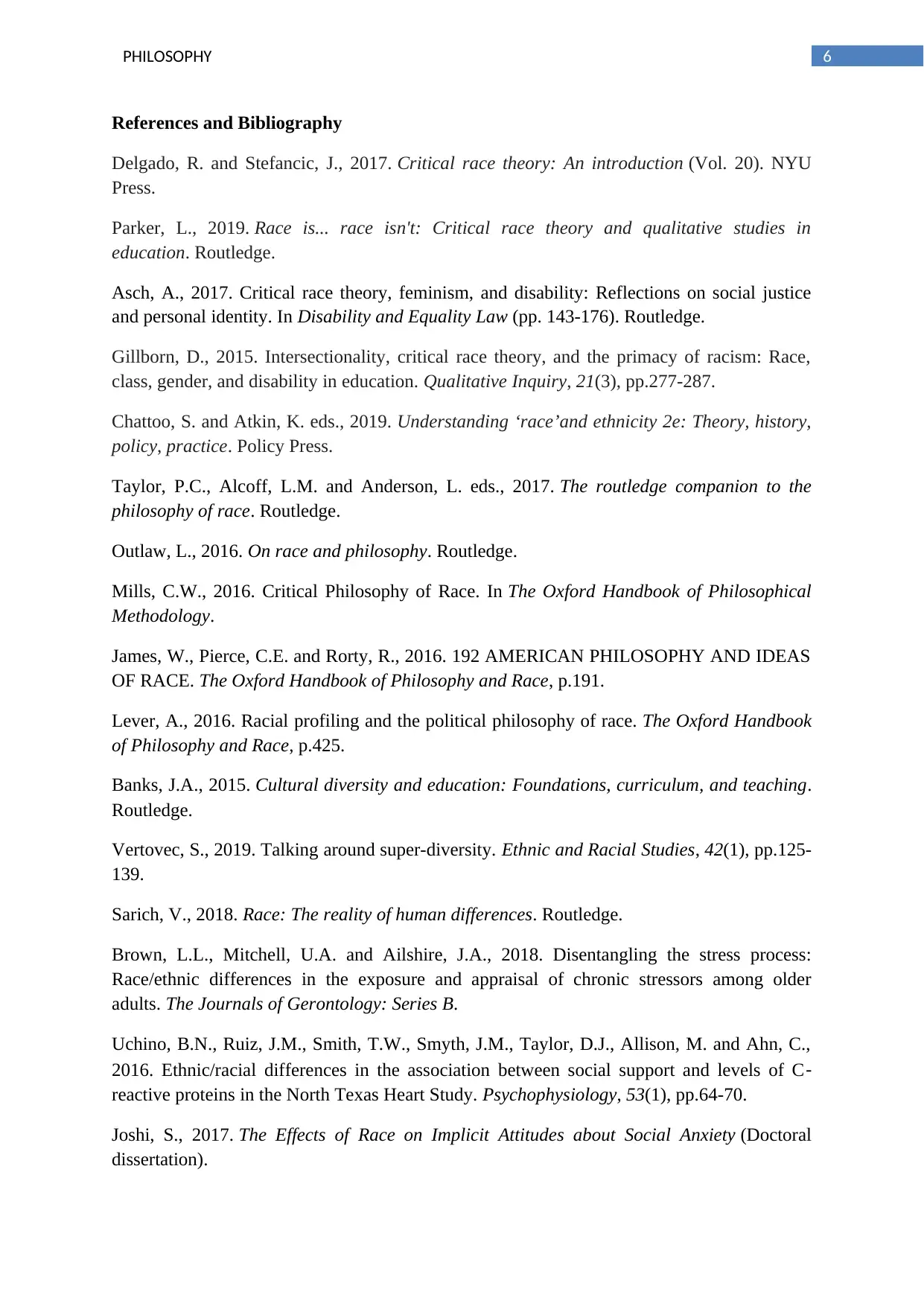
6PHILOSOPHY
References and Bibliography
Delgado, R. and Stefancic, J., 2017. Critical race theory: An introduction (Vol. 20). NYU
Press.
Parker, L., 2019. Race is... race isn't: Critical race theory and qualitative studies in
education. Routledge.
Asch, A., 2017. Critical race theory, feminism, and disability: Reflections on social justice
and personal identity. In Disability and Equality Law (pp. 143-176). Routledge.
Gillborn, D., 2015. Intersectionality, critical race theory, and the primacy of racism: Race,
class, gender, and disability in education. Qualitative Inquiry, 21(3), pp.277-287.
Chattoo, S. and Atkin, K. eds., 2019. Understanding ‘race’and ethnicity 2e: Theory, history,
policy, practice. Policy Press.
Taylor, P.C., Alcoff, L.M. and Anderson, L. eds., 2017. The routledge companion to the
philosophy of race. Routledge.
Outlaw, L., 2016. On race and philosophy. Routledge.
Mills, C.W., 2016. Critical Philosophy of Race. In The Oxford Handbook of Philosophical
Methodology.
James, W., Pierce, C.E. and Rorty, R., 2016. 192 AMERICAN PHILOSOPHY AND IDEAS
OF RACE. The Oxford Handbook of Philosophy and Race, p.191.
Lever, A., 2016. Racial profiling and the political philosophy of race. The Oxford Handbook
of Philosophy and Race, p.425.
Banks, J.A., 2015. Cultural diversity and education: Foundations, curriculum, and teaching.
Routledge.
Vertovec, S., 2019. Talking around super-diversity. Ethnic and Racial Studies, 42(1), pp.125-
139.
Sarich, V., 2018. Race: The reality of human differences. Routledge.
Brown, L.L., Mitchell, U.A. and Ailshire, J.A., 2018. Disentangling the stress process:
Race/ethnic differences in the exposure and appraisal of chronic stressors among older
adults. The Journals of Gerontology: Series B.
Uchino, B.N., Ruiz, J.M., Smith, T.W., Smyth, J.M., Taylor, D.J., Allison, M. and Ahn, C.,
2016. Ethnic/racial differences in the association between social support and levels of C‐
reactive proteins in the North Texas Heart Study. Psychophysiology, 53(1), pp.64-70.
Joshi, S., 2017. The Effects of Race on Implicit Attitudes about Social Anxiety (Doctoral
dissertation).
References and Bibliography
Delgado, R. and Stefancic, J., 2017. Critical race theory: An introduction (Vol. 20). NYU
Press.
Parker, L., 2019. Race is... race isn't: Critical race theory and qualitative studies in
education. Routledge.
Asch, A., 2017. Critical race theory, feminism, and disability: Reflections on social justice
and personal identity. In Disability and Equality Law (pp. 143-176). Routledge.
Gillborn, D., 2015. Intersectionality, critical race theory, and the primacy of racism: Race,
class, gender, and disability in education. Qualitative Inquiry, 21(3), pp.277-287.
Chattoo, S. and Atkin, K. eds., 2019. Understanding ‘race’and ethnicity 2e: Theory, history,
policy, practice. Policy Press.
Taylor, P.C., Alcoff, L.M. and Anderson, L. eds., 2017. The routledge companion to the
philosophy of race. Routledge.
Outlaw, L., 2016. On race and philosophy. Routledge.
Mills, C.W., 2016. Critical Philosophy of Race. In The Oxford Handbook of Philosophical
Methodology.
James, W., Pierce, C.E. and Rorty, R., 2016. 192 AMERICAN PHILOSOPHY AND IDEAS
OF RACE. The Oxford Handbook of Philosophy and Race, p.191.
Lever, A., 2016. Racial profiling and the political philosophy of race. The Oxford Handbook
of Philosophy and Race, p.425.
Banks, J.A., 2015. Cultural diversity and education: Foundations, curriculum, and teaching.
Routledge.
Vertovec, S., 2019. Talking around super-diversity. Ethnic and Racial Studies, 42(1), pp.125-
139.
Sarich, V., 2018. Race: The reality of human differences. Routledge.
Brown, L.L., Mitchell, U.A. and Ailshire, J.A., 2018. Disentangling the stress process:
Race/ethnic differences in the exposure and appraisal of chronic stressors among older
adults. The Journals of Gerontology: Series B.
Uchino, B.N., Ruiz, J.M., Smith, T.W., Smyth, J.M., Taylor, D.J., Allison, M. and Ahn, C.,
2016. Ethnic/racial differences in the association between social support and levels of C‐
reactive proteins in the North Texas Heart Study. Psychophysiology, 53(1), pp.64-70.
Joshi, S., 2017. The Effects of Race on Implicit Attitudes about Social Anxiety (Doctoral
dissertation).
Paraphrase This Document
Need a fresh take? Get an instant paraphrase of this document with our AI Paraphraser

7PHILOSOPHY
1 out of 8
Related Documents
Your All-in-One AI-Powered Toolkit for Academic Success.
+13062052269
info@desklib.com
Available 24*7 on WhatsApp / Email
![[object Object]](/_next/static/media/star-bottom.7253800d.svg)
Unlock your academic potential
Copyright © 2020–2025 A2Z Services. All Rights Reserved. Developed and managed by ZUCOL.





